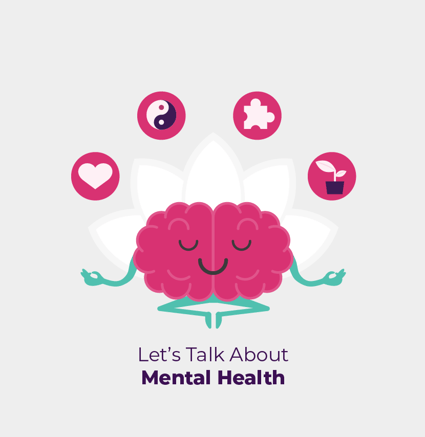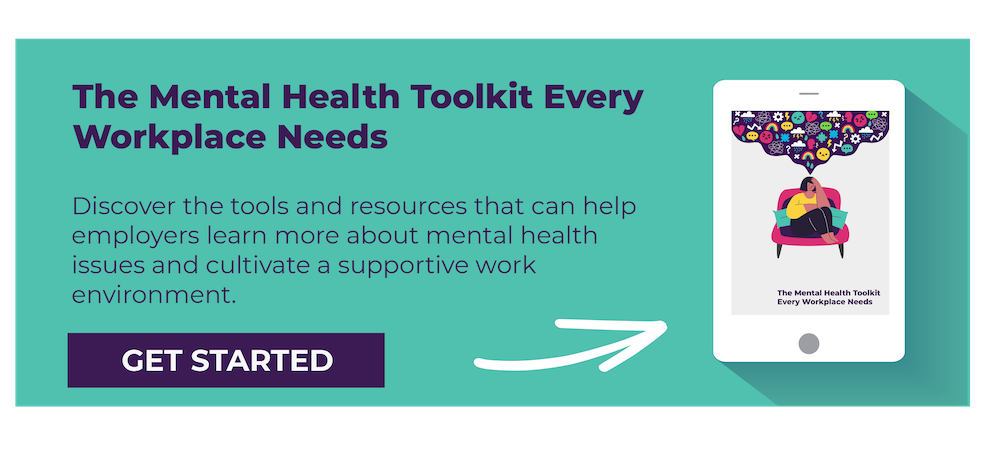 Mental health isn’t an easy topic to talk about.
Mental health isn’t an easy topic to talk about.
Not discussing it at all in the workplace can be harmful, though.
For one, employees lose out on valuable resources that could potentially improve or save their lives. On the other hand, employers miss the chance to break the stigma that surrounds mental illness discussions.
Considering serious mental illness causes $193.2 billion in lost earnings each year, it’s a topic too big to be ignored by companies.
This month, consider starting a mental health dialogue with employees. October’s three mental health observances offer perfect conversation starters:
There’s no better time to start the conversations than now. Below, we share just how to build mental health awareness and empathy in the workplace.
Mental Illness Observances in October
There are three major mental illness awareness events employers can promote throughout the month of October. Whether your company participates in one or all three, you’ll be getting valuable mental health information in front of employees who might not know where to look otherwise.
Mental Illness Awareness Week 2019
October 6-12, 2019
The National Alliance on Mental Illness (NAMI) and participants across the United States take part in this event to educate the public about mental illness. The observance was established by Congress in 1990 as a way to spread awareness and try to end the stigma against mental illness. Download logos, social media images, and other marketing materials here.
World Mental Health Day 2019
October 10, 2019
Organized by the World Federation for Mental Health, this one-day event is for uniting communities in an effort to improve mental health globally. This year’s theme is suicide prevention as every 40 seconds someone dies by suicide. This event is an ideal time for employers to share local mental health resources and go over company sponsored mental health benefits.
National Depression Screening Day
October 11, 2019
National Depression Screening Day is a part of Mental Illness Awareness Week. Each year, organizations are encouraged to offer free screenings around the community to get people the help they need if they’re depressed. By next year, depression will be the second leading cause of disability, according to the World Health Organization (WHO). For employees who can get ahead of a depression diagnosis by getting screened, it can reduce absenteeism and increase their workplace productivity.
What is Mental Illness?
Mental illness can be any condition that impacts mood, thinking, or behavior. Because mental illness can be all encompassing, it can have a detrimental impact on a person’s ability to function and/or relate to other people.
Common types of mental illnesses include:
- Anxiety disorders
- Eating disorders
- Psychotic disorders
- Post-traumatic stress disorder (PTSD)
- Mood disorders
- Obsessive-compulsive disorder (OCD)
One important note to keep in mind is that even people with the same diagnosis can have very different symptoms. These symptoms can be both temporary or chronic, but many are treatable with medication, talk therapy, and other methods.
Mental Illness Statistics to Share With Employees
Throughout October and during mental health observance days, share resources and mental health statistics with your employees. It can help employees realize they aren’t alone in needing mental health help. It may also help them or even a loved one get information or resources they need to live a more fulfilling, mentally healthy life.
A Look at Mental Illness Stats
Unfortunately, the average delay between the onset of mental illness symptoms and treatment is 11 years. The sooner an employee can access resources, the sooner they can get help in managing symptoms.
Mental illness statistics:
- In 2018 alone, 47.6 million U.S. adults experienced mental illness
- 1 in 25 adults experienced serious mental illness conditions in 2018
- A co-occurring substance use disorder is common with mental illness
- 3% of adults with mental illness received treatment in 2018
- 4 million people care for an adult with mental or emotional health issues
- Depression sufferers have a 40% higher risk of having cardiovascular diseases
- Unemployment rates are higher among U.S. adults who have mental illness
Suicide Statistics
Suicide is perhaps one of the hardest topics to talk about when it comes to mental illness. Unfortunately, when proper help isn’t sought for mental illness (or treatment methods are incorrect), the person with a mental illness becomes a statistic. The National Alliance on Mental Illness (NAMI) reports that 90% of people who commit suicide have shown prior symptoms of a mental health condition.
Here’s a look at suicide statistics in the U.S. alone:
- The second leading cause of death among people aged 10-34 is suicide
- Since 2001, the overall suicide rate in the U.S. has increased 31%
- 75% of suicide deaths are male
- Suicide is the 10th leading cause of death
- 46% of people who die by suicide had a diagnosed mental health condition
If you or someone you know needs mental help quickly, call 988 Suicide & Crisis Lifeline at 988.
Causes of Mental Illness
There is not just one cause for mental illness. It’s important to note these are not character flaws, either. A number of physical factors and environmental triggers can increase risks for mental illness, including:
- Genetics and family history
- Life experiences (traumatic childhood events)
- Biological factors (chemical brain imbalances)
- Brain injury
- Alcohol and drug use
- Dealing with a serious medical condition
- Feeling lonely or isolated due to little social interaction
Warning Signs of Mental Illness
Sometimes friends, coworkers, and family members can see a mental illness coming on if they know the signs. Every person is different, so the person dealing with a mental health concern may have some or all of these warning signs.
Mental health warning signs to watch for include:
- Sleep, appetite, or personal care changes
- Rapid and/or extreme shifts in moods or emotions
- Social withdrawal
- New levels of poor performance
- Denying obvious problems
- Cognitive issues (poor concentration, memory loss, etc.)
- Apathy or a feeling of disconnect
- Unusual and illogical thinking
- Increased fear, nervousness, and suspicion of others
Understanding warning signs can help individuals reach out for help for a proper diagnosis and treatment. For employers, this is why depression screening days in particular are an excellent idea. It can help employees get started on treatment for depression and any other mental health issues they’ve been experiencing.
Removing the Stigma at Work and Beyond
Stigmas may prevent people from recognizing and seeking treatment.
In fact, 8 out of 10 workers stated this to be the case. By creating a stigma-free workplace, it allows employees to feel confident in the fact that they can discuss mental illness without negative consequences.
By allowing employees to come forth and confidentially discuss mental health issues, it may reduce absenteeism if an employer is open to making accommodations. According to NAMI, over half of employee missed work days are due to mental illnesses.
And, a company could lose good workers if they don’t offer flexibility for “off days” for someone dealing with mental health issues.
Ways Employers Can Help Remove the Stigma
There are a few different ways to encourage an employee who is working through mental health issues. Developing a caring and empathetic work culture can improve retention rates and promote a healthier work environment where employees feel safe.
Employers can prioritize mental health and minimize stigma with a few adjustments like the following recommendations:
- Start at the top — Executives should start the conversation about mental health and the importance of self care, including seeking appropriate help when needed.
- Be supportive — Create an inclusive environment that builds empathy among coworkers.
- Build a healthy culture — Start conversations that show mental illness as a condition, not a reflection on the person. Promote getting help as a strength — not a weakness — to encourage employees dealing with mental health concerns to get help sooner.
- Educate — Use your wellness program to educate and provide resources for self help and self care. Bringing in a therapist to discuss ways of recognizing symptoms, improving mental health, and seeking outside help can also be helpful.
- Take advantage of free resources — Use resources such as NAMI’s Stigma-Free Company Program to change the way your workplace views mental health.
Make Mental Health Discussions Regular Conversation
Mental illness touches one in five adults and their families, so there’s a good chance your employees are grappling with the impact it can have on daily life.
The great news is, treatment is readily available and usually successful. That’s why sharing information about mental illness through observances like Mental Health Awareness Week 2019 can be so helpful to employees.
Take advantage of October’s mental health days and use your wellness program to create a stigma-free environment at your workplace. Ask for feedback on the best ways to incorporate mental health discussions in the workplace, too.
By doing so, you may inspire others to seek the help they need and let them know they aren’t alone in managing their conditions.
Like this blog post? You may find our 5 Ways to Fight the Stigma of Mental Illness in the Workplace post helpful, too.



